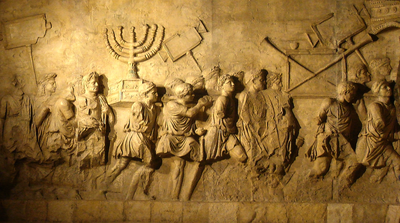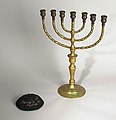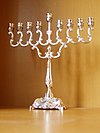Temple menorah

The menorah (Template:Lang-he [mənoːˈɾaː]) is described in the Bible as the seven-lamp (six branches) ancient Hebrew lampstand made of gold and used in the portable sanctuary set up by Moses in the wilderness and later in the Temple in Jerusalem. Fresh olive oil of the purest quality was burned daily to light its lamps. The menorah has been a symbol of Judaism since ancient times and is the emblem on the coat of arms of the modern state of Israel.
Construction
The menorah consisted of a base and a shaft with six branches, beaten out of solid gold. The six branches curved to the height of the central shaft so that all seven lamps at their apexes were in a straight line.[1]
The Hebrew Bible, or Torah, states that God revealed the design for the menorah to Moses and describes the construction of the menorah as follows (Exodus 25:31–40):
31 And you must make a lampstand of pure gold. Of hammered work the lampstand is to be made. Its base, its branches, its cups, its knobs and its blossoms are to proceed out from it. 32 And six branches are running out from its sides, three branches of the lampstand from its one side and three branches of the lampstand from its other side. 33 Three cups shaped like flowers of almond are on the one set of branches, with knobs and blossoms alternating, and three cups shaped like flowers of almond on the other set of branches, with knobs and blossoms alternating. This is the way it is with the six branches running out from the lampstand. 34 And on the lampstand are four cups shaped like flowers of almond, with its knobs and its blossoms alternating. 35 And the knob under two branches is out of it and the knob under the two other branches is out of it and the knob under two more branches is out of it, for the six branches running out from the lampstand. 36 Their knobs and their branches are to proceed out from it. All of it is one piece of hammered work, of pure gold. 37 And you must make seven lamps for it; and the lamps must be lit up, and they must shine upon the area in front of it. 38 And its snuffers and its fire holders are of pure gold. 39 Of a talent of pure gold he should make it with all these utensils of it. 40 And see that you make them after their pattern that was shown to you in the mountain.
The branches are often artistically depicted as semicircular, but Rashi[2] may be interpreted as saying they were straight, and Maimonides,[3] according to his son Avraham,[4] held that they were straight.
Archaeological evidence, including depictions by artists who had seen the menorah, indicates that they were neither straight nor semicircular but elliptical.[5]
Until 2009, the earliest preserved representation of the menorah of the Temple was depicted in a frieze on the Arch of Titus, commemorating his triumphal parade in Rome following the destruction of Jerusalem in the year 70AD.
In 2009, however, the ruins of a synagogue with pottery dating from before the destruction of the Second Temple were discovered under land in Magdala owned by the Legionaries of Christ, who had intended to construct a center for women's studies.[6] Inside that synagogue's ruins was discovered a rectangular stone, which had on its surface, among other ornate carvings, a depiction of the seven-lamp menorah differing markedly from the depiction on the Arch of Titus, probably carved by an eyewitness to the actual menorah present at the time in the Temple at Jerusalem. This menorah has arms which are polygonal, not rounded, and the base is not graduated but triangular.
Representations of the seven lamp artifact have been found on tombs and monuments dating from the 1st century as a frequently used symbol of Judaism and the Jewish people.[1]
It has been noted that the shape of the menorah bears a certain resemblance to that of the plant Salvia palaestina.[7][8]
Contrary to some modern designs, the ancient menorah did not contain anything resembling seven candles as they did not exist then.
Use
The lamps of the menorah were lit daily from fresh, consecrated olive oil and burned from evening until morning, according to Exodus 27:21.
The Roman-Jewish historian Flavius Josephus states that three of the seven lamps were allowed to burn during the day also; however, according to the Talmud (Rashi, Tractate Shabbat 22b), only the center lamp was left burning all day, into which as much oil was put as into the others. Although all the other lights were extinguished, that light burned oil, in spite of the fact that it had been kindled first. This miracle according to the Talmud (Tractate Menahot 86b) was taken as a sign that the Shechinah rested over Israel.[9] It was called the ner hama'aravi (Western lamp) because of its position. This lamp was also referred to as the ner Elohim (lamp of God), mentioned in I Samuel 3:3.[1] The miracle of the ner hama'aravi ended about 40 years before the destruction of the Temple (c. 30 CE) according the Talmud Tractate (Yoma 39a), "Our Rabbis taught: During the last forty years before the destruction of the Temple (that is to say around 30 AD) the lot [‘For the Lord’] did not come up in the right ...hand; nor did the crimson-coloured strap become white; nor did the westernmost light shine"[10]
History and fate
The original menorah was made for the Tabernacle, and the Bible records it as being present until the Israelites crossed the Jordan river. When the Tabernacle is pitched in Shiloh (Joshua 18:1), it assumed that the menorah was also present. However, no mention is made of it during the years that the Ark of the Covenant was moved in the times of Samuel and Saul. There is no further mention of the menorah in Solomon's temple, except in (2 Chronicles 4:7) as he creates ten lampstands. These are recorded as being taken away to Babylon by the invading armies under the general Nebuzar-Adan (Jeremiah 52:19) some centuries later.
During the restoration of the Temple worship after the 70-year captivity in Babylon, no mention is made of the return of the menorah but only of "vessels" (Ezra 1:9–10). Since the Temple was an enclosed place with no natural light, some means of illumination must have existed.

The Book of Maccabees record that Antiochus Epiphanes took away the lampstands(plural) when he invaded and robbed the Temple (1 Maccabees 1:21). The later record of the making of "new holy vessels" may refer to the manufacture of new lampstands(1 Maccabees 4:49). There is thereafter no Biblical mention of the fate of the menorah.
The fate of the menorah used in the Third Temple - Herod's Temple - is recorded by Josephus, who states that it was brought to Roma and carried along during the triumph of Vespasian and Titus. The menorah probably remained in the Temple of Peace in Rome until the city was sacked by the Visigoths under Alaric I in 410 CE.
Most likely, the menorah was looted by the Vandals in the sacking of Rome in 455 CE, and taken to their capital, Carthage.[11] The Byzantine army under General Belisarius might have removed it in 533 and brought it to Constantinople. According to Procopius, it was carried through the streets of Constantinople during Belisarius' triumphal procession. Procopius adds that the object was later sent back to Jerusalem where there is no record of it, although it could have been destroyed when Jerusalem was pillaged by the Persians in 614.
Symbolism

The menorah symbolized the ideal of universal enlightenment.[12] The seven lamps allude to the branches of human knowledge, represented by the six lamps inclined inwards towards, and symbolically guided by, the light of God represented by the central lamp. The menorah also symbolizes the creation in seven days, with the center light representing the Sabbath.[1] It is also said to symbolize the burning bush as seen by Moses on Mount Horeb (Exodus 3).[13]
The word 'menorah' has seven letters representing the seven lamps.[14]. According to Clement of Alexandria and Philo Judaeus, the seven lamps of the golden menorah represented the seven planets in this order: the Moon, Mercury, Venus, the Sun, Mars, Jupiter, and Saturn.[15]
Hanukkah (Chanukah)
The Menorah is also a symbol closely associated with the Jewish holiday of Hanukkah (Chanukah). According to the Talmud, after the Seleucid desecration of the Jewish Temple in Jerusalem, there was only enough sealed (and therefore not desecrated) consecrated olive oil left to fuel the eternal flame in the Temple for one day. Miraculously, the oil burned for eight days which was enough time to make new pure oil.
The Talmud (Menahot 28b) states that it is prohibited to use a seven-lamp menorah outside of the Temple. The Hanukkah menorah therefore has eight main branches, plus the middle ninth lamp set apart as the shamash (servant) light which is used to kindle the other lights. This type of menorah is called a hanukiah in Modern Hebrew.[1]
Modern use
Synagogues have a continually lit lamp or light in front of the Ark, where the Torah scroll is kept, called the ner tamid (eternal light). This lamp represents the continually lit ner Elohim of the menorah used in Temple times.[1]
In addition, many synagogues display either a Menorah or an artistic representation of a menorah.
A menorah appears in the coat of arms of the State of Israel, based on the depiction of the menorah on the Arch of Titus.
Sometimes when teaching learners of the Hebrew language, a chart shaped like the seven-lamp menorah is used to help students remember the role of the binyanim of the Hebrew verb.
In other cultures
The kinara is also, like the menorah, a seven candleholder which is associated with the African American festival of Kwanzaa. One candle is lit on each day of the week-long celebration, in a similar manner as the Hanukiah (which was modeled after the menorah) during Hanukkah.
In the Orthodox Church the use of the menorah has been preserved, always standing on or behind the altar in the sanctuary.[16] Though candles may be used, the traditional practice is to use olive oil in the seven-lamp lampstand. There are varying liturgical practices, and usually all seven lamps are lit for the services, though sometimes only the three centermost are lit for the lesser services. If the church does not have a sanctuary lamp the centermost lamp of the seven lamps may remain lit as an eternal flame.
In Taoism, the Seven-Star Lamp qi xing deng 七星燈 is a seven-lamp oil lamp lit to represent the 7 stars of the Northern Dipper.[17] This lampstand is a requirement for all Taoist temples, never to be extinguished. In the first 9 days of the lunar 9th month festival, an oil lamp of 9 connected lamps may also be lit to honour both the Northern Dipper and 2 other assistant stars (collectively known as the Nine Emperor Stars), sons of Dou Mu appointed by the Taoist Trinity (the Three Pure Ones) to hold the Books of Life and Death of humanity. The lamps represent the illumination of the 7 stars, and lighting them are believed to absolve sins while prolonging one's lifespan.[citation needed]
Further reading
- Rachel Hachlili, The Menorah, the Ancient Seven-armed Candelabrum: Origin, Form, and Significance (Leiden, Brill, 2001). ISBN 90-04-12017-3
Gallery
-
Coin depicting a menorah issued by the last Hasmonean king, Mattathias Antigonus, c. 40 BCE
-
Maimonides' drawing of the menorah
-
The Jewish Legion cap badge: menorah and word קדימה Kadima (forward)
-
The Coat of Arms of Israel shows a menorah surrounded by an olive branch on each side and the writing "ישראל" (Israel) based on its depiction on the Arch of Titus.
-
The Menorah is seen being sacked as the Holy Temple in Jerusalem was being destroyed by the Roman army. (70 CE)
-
Menorah monument at Jewish Cemetery of Theresienstadt concentration camp
-
In this 1806 French print, the woman with the Menorah represents the Jews being emancipated by Napoleon Bonaparte
-
Kippa and Menorah from the Harry S Truman collection
-
Sephardic style Menorah from Spain
See also
- Menorah (Hanukkah)
- Jewish symbols
- Arch of Titus
- Hanukkah
- Knesset Menorah
- Mishneh Torah Avodah Laws of the Temple 3:1-10
References
- ^ a b c d e f Birnbaum, Philip (1975). A Book of Jewish Concepts. New York: Hebrew Publishing Company. pp. 366–367. ISBN 88482876X.
{{cite book}}: Check|isbn=value: length (help) - ^ Exodus 25:32
- ^ Maimonides depicted them as straight in two separate manuscript drawings. But see Seth Mandel's alternative interpretation below.
- ^ Commentary on Exodus, ch 7
- ^ Mandel, Seth The shape of the Menorah of the Temple Avodah Mailing List, Vol 12 Num 65
- ^ http://www.regnumchristi.org/english/articulos/articulo.phtml?se=364&ca=118&te=782&id=27331
- ^ JTS Taste of Torah commentary, 18 June 2005
- ^ Talmud Tractate Yoma 22b and 39a (PDF).
- ^ Talmud Bavli Tractate Yoma (PDF).
- ^ Talmud Tractate Yoma (PDF). pp. 39b.
- ^ Edward Gibbon: The History of the Decline and Fall of the Roman Empire (Volume 7: Chapter XLI. From the Online Library of Liberty. The J. B. Bury edition, in 12 volumes.)
- ^ Chanan Morrison, Abraham Isaac Kook, Gold from the Land of Israel: A New Light on the Weekly Torah Portion - From the Writings of Rabbi Abraham Isaac HaKohen Kook, page 239 (Urim Publications, 2006). ISBN 965-7108-92-6
- ^ Robert Lewis Berman, A House of David in the Land of Jesus, page 18 (Pelican, 2007). ISBN 978-1-58980-720-4
- ^ citation needed
- ^ p.10, Morals and Dogma of the Ancient and Accepted Scottish Rite of Freemasonry by Albert Pike (L.H. Jenkins, 1871 [1948])
- ^ Hapgood, Isabel (1975) [1922]. "Service Book of the Holy Orthodox-Catholic Apostolic Church" (Document). Englewood NJ: Antiochian Orthodox Christian Archdiocese. p. xxxTemplate:Inconsistent citations
{{cite document}}: Unknown parameter|edition=ignored (help)CS1 maint: postscript (link) - ^ Jeaneane D. Fowler, An Introduction to the Philosophy and Religion of Taoism: Pathways to Immortality, page 213 (Sussex Academic Press, 2005). ISBN 1-84519-085-8
External links
- JewishEncyclopedia.com: Candlestick - By Emil G. Hirsch, Wilhelm Nowack
- JewishEncyclopedia.com: Arch of Titus - By Morris Jastrow Jr., Immanuel Benzinger
- JewishEncyclopedia.com: Menorah - By Cyrus Adler, Judah David Eisenstein















